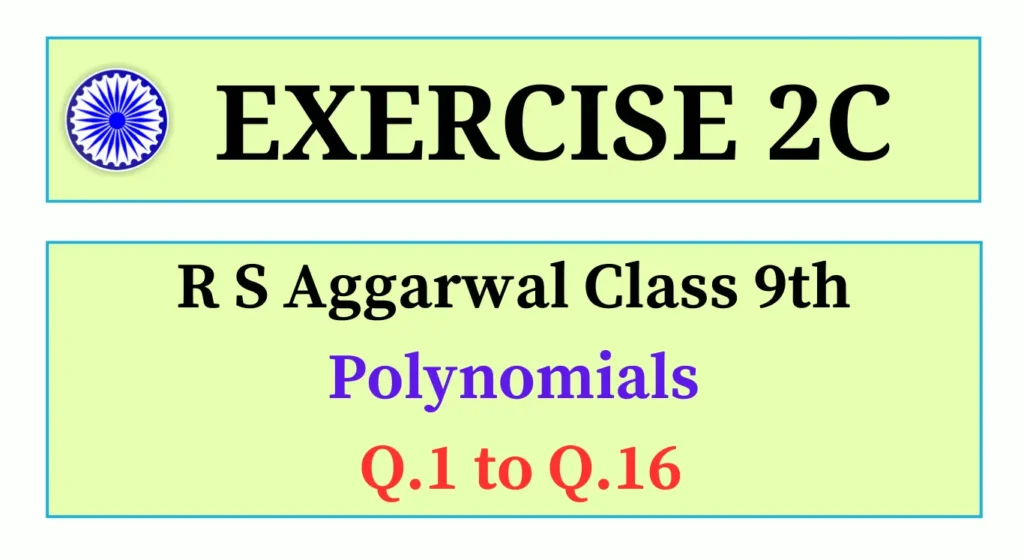
Exercise 2C RS Aggarwal Class 9 contains a total of sixteen questions. The questions are based on the following topics.
- Division Algorithm in Polynomials
- Remainder Theorem
Exercise 2C RS Aggarwal Class 9 Mathematics Solutions
The first question in Exercise 2C RS Aggarwal Class 9 asks us to find the quotient and remainder by doing actual division.
1. By actual division, find the quotient and the remainder when is divided by .
Verify that remainder = .
Answer

From the above division, we see that remainder when is divided by is 2 and quotient is .
Verification:
Putting , we get.
.
Hence, verified!
The second question of Exercise 2C RS Aggarwal Class 9 asks us to verify the division algorithm for the polynomials.
2. Verify the division algorithm for the polynomials
and .
Answer
Given polynomials are
and .

After dividing by , we get.
Quotient =
Remainder = 92
Verification of Division Algorithm:
To verify:
i.e.
Taking Right Hand Side (RHS), we have,
= Dividend.
Hence, verified!
The questions from third to twelfth from Exercise 2C RS Aggarwal Class 9 asks us to use remainder theorem to find remainder.
Using the remainder theorem, find the remainder, when is divided by , where
3.
Answer
We have
.
Here, = 0
According to remainder theorem, when is divided by , the remainder is .
Hence, the remainder when is divided by is 7.
4.
Answer
We have
Here,
According to remainder theorem, when is divided by , the remainder is .
.
Hence, the remainder when is divided by is 5.
5.
Answer
We have
Here,
.
According to remainder theorem, when is divided by , the remainder is .
.
Hence, the remainder when is divided by is 6.
6.
Answer
We have
Here,
According to remainder theorem, when is divided by , the remainder is .
.
Hence, the remainder when is divided by is 3.
7.
Answer
We have
Here,
.
According to remainder theorem, when is divided by , the remainder is .
.
Hence, the remainder when is divided by is 4.
8.
Answer
We have
Here,
.
According to remainder theorem, when is divided by , the remainder is .
.
Hence, the remainder when is divided by is 6.
9.
Answer
We have
Here,
.
According to remainder theorem, when is divided by , the remainder is .
.
Hence, the remainder when is divided by is 7.
10.
Answer
We have
Here,
.
According to remainder theorem, when is divided by , the remainder is .
.
Hence, the remainder when is divided by is .
11.
Answer
We have
Here,
According to remainder theorem, when is divided by , the remainder is .
Hence, the remainder when is divided by is .
12.
Answer
We have
Here,
.
According to remainder theorem, when is divided by , the remainder is .
.
Hence, the remainder when is divided by is .
In Exercise 2C RS Aggarwal Class 9, the thirteenth question is a word problem on remainder theorem.
13. The polynomials and when divided by leave the same remainder. Find the value of a.
Answer
Let
. . . (1) and
. . . (2)
Here,
.
According to remainder theorem, when and are divided by , the obtained remainders are and respectively.
Since the remainder obtained when is divided by is equal to the remainder obtained when is divided by .
.
Hence, the value of is 8.
In Exercise 2C RS Aggarwal Class 9, the fourteenth question is a word problem that has been comprehensively solved below.
14. The polynomial when divided by and leaves the remainders 5 and 19 respectively. Find the values of and . Hence, find the remainder when is divided by .
Answer
We have
According to remainder theorem, when is divided by , the remainder is .
. . . (1)
Also, when is divided by , the remainder is .
. . . (2)
Solving equations (1) and (2) by adding, we get.
putting in equation (2), we get.
Putting the values of and in , we get.
.
Now, the remainder when is divided by is .
.
Hence, the remainder when is divided by is 10.
In Exercise 2C RS Aggarwal Class 9, the fifteenth question is a word problem and its comprehensive solution is given below.
15. If and show that is not a multiple of .
Answer
We have,
We know that is a multiple of if the remainder obtained is zero when is divided by .
According to remainder theorem, when is divided by , the remainder is .
∵ The remainder is not equal to zero, the given polynomial is not a multiple of .
In Exercise 2C RS Aggarwal Class 9, the sixteenth question is about the application of factor theorem.
16. If and , show that is not a factor of .
Answer
We have
Here,
.
For to be a factor of , the remainder obtained when is divided by must be zero.
Putting in , we get.
, is not a factor of .
Hence, proved!
